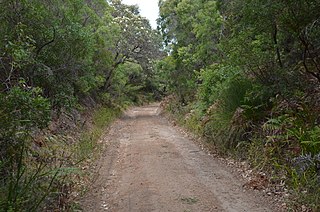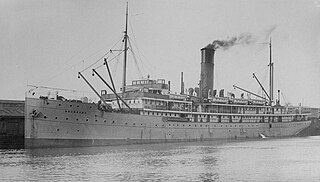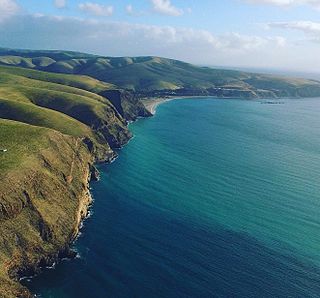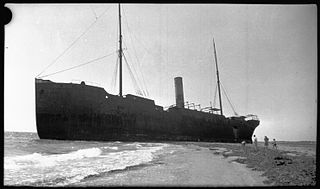
Charles Yelverton O'Connor,, was an Irish engineer who is best known for his work in Western Australia, especially the construction of Fremantle Harbour, thought to be impossible, and the Goldfields Water Supply Scheme.

Busselton is a city in the South West region of the state of Western Australia approximately 220 km (140 mi) south-west of Perth. Busselton has a long history as a popular holiday destination for Western Australians; however, the closure of the Busselton Port in 1972 and the contemporaneous establishment of the nearby Margaret River wine region have seen tourism become the dominant source of investment and development, supplemented by services and retail. The city is best known for the Busselton Jetty, the longest wooden jetty in the Southern Hemisphere.

SS Georgette was a steamship built in 1872. She is best known, especially in Irish-American circles, for the part played in the story of the Catalpa rescue in April 1876. While the events surrounding her shipwrecking eight months later are dramatic and did capture the imagination of the local press, the ship itself had little effect on the coastal trade. Though heralding the way forward in the change from sail to steam on the long Western Australian coast, like its predecessor SS Xantho, Georgette had a short and ill-starred career and sank soon after its arrival there.

William Henry "Bully" Hayes was a notorious American ship's captain who engaged in blackbirding in the 1860s and 1870s.

The Flinders Bay Branch Railway, also known as the Boyanup to Flinders Bay Section ran between Boyanup and Flinders Bay, in South Western Western Australia. The section from Flinders Bay to Busselton has now been converted into a rail trail for bushwalkers and cyclists, called the Wadandi Trail.

Busselton Jetty is a jetty located in Busselton, Western Australia. It is the longest timber-piled jetty (pier) in the Southern Hemisphere at 1,841 metres (6,040 ft) long. The jetty is managed by a not-for-profit community organisation, Busselton Jetty Inc.
Over 1400 ships have been wrecked on the coast of Western Australia. This relatively large number of shipwrecks is due to a number of factors, including:

SS Koombana was a passenger steamship that was built in Scotland in 1908 for the Adelaide Steamship Company, for coastal liner services between Fremantle and the northwest coast of Western Australia. She sank in a tropical cyclone somewhere off Port Hedland in 1912, with the loss of all 150 people aboard. Her loss was one of Australia's worst weather-related maritime disasters in the twentieth century.

Rapid Bay is a locality that includes a small seaside town and bay on the west coast of the Fleurieu Peninsula, South Australia. It lies within the District Council of Yankalilla and its township is approximately 100 km south of the state capital, Adelaide. A pair of jetties are popular attractions for recreational fishing, scuba diving and snorkelling. The bay particularly known as a site for observing leafy seadragons in the wild. Its postcode is 5204.

Port Willunga is a semi-rural suburb of Adelaide, South Australia. It is known as Wirruwarrungga or Ruwarunga by the traditional owners, the Kaurna people, and is of significance as being the site of a freshwater spring said to be created by the tears of Tjilbruke, the creator being.
Quindalup is a small town in the South West region of Western Australia. It is situated along Caves Road between Busselton and Dunsborough on Geographe Bay. At the 2021 census, Quindalup had a population of 1,488.
Henry Yelverton was an Australian sawmiller and timber merchant.

SS Kwinana was an Australian ocean-going cargo and passenger steamship. She was built in England in 1892 as the cargo ship SS Darius. In 1912 she changed owners, was refitted as a cargo and passenger ship and renamed Kwinana.

SS Pericles was a UK steam ocean liner and refrigerated cargo ship. She was launched in 1907 in Ireland for the Aberdeen Line service between Great Britain and Australia via South Africa. When new, she was the largest ship on the route.

Iserbrook was a general cargo and passenger brig built in 1853 at Hamburg (Germany) for Joh. Ces. Godeffroy & Sohn. It spent over twenty years as an immigrant and general cargo vessel, transporting passengers from Hamburg to South Africa, Australia and Chile, as well as servicing its owner's business in the Pacific. Later on, the vessel came into Australian possession and continued sailing for the Pacific trade. In 1878 it caught fire and was sunk the same year. At last, it was re-floated and used as a transport barge and hulk in Sydney until it sank again and finally was blown up.
The Arpenteur was a brig owned by William Owen and John Ridley. It was wrecked at Hassell Beach in Cheyne Bay near Cape Riche when a gale ran it ashore 7 November 1849.
Wave was a brig that was wrecked in 1848 at Cheynes Beach near Cape Riche, Western Australia.
John Ralph Hansford Ward, invariably known as Hansford Ward or Captain Ward, was a ship's captain in South Australia, who figures prominently in the pre-history of the Adelaide Steamship Company. A son, also named John Ralph Hansford Ward but known as John R. H. Ward, was also a ship's captain.
The coastal coal-carrying trade of New South Wales involved the shipping of coal—mainly for local consumption but also for export or coal bunkering—by sea to Sydney from the northern and southern coal fields of New South Wales. It took place in the 19th and 20th centuries. It should not be confused with the export coal trade, which still exists today. There was also an interstate trade, carrying coal and coke to other Australian states that did not have local sources of black coal.












